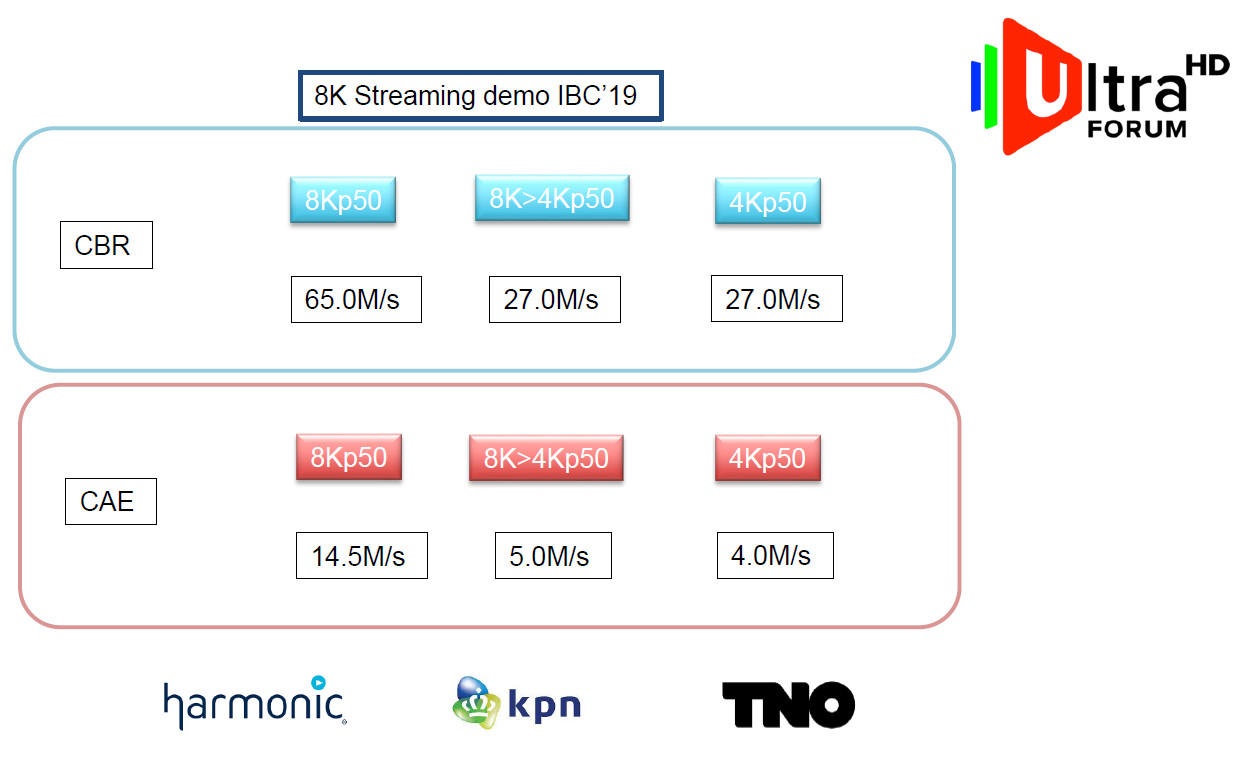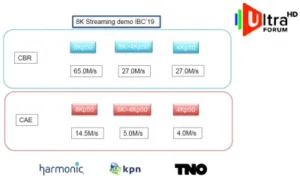IBC 2019 saw several innovations in 8K delivery including new options for 8K live encoding and 8K streaming (including 8K/50p down-sampled to 4K and delivered at data rates as low as 14.5 Mbps with impressive image quality – we were told).

Currently, NHK is broadcasting 8K content for 12 hours per day using a satellite delivery system which requires HEVC encoding at 100 Mbps for an 8K/60p, 10-bit, 4:2:0 signal. To reduce this data rate, NHK is looking to Versatile Video Encoding (VVC), the successor to HEVC, to lower the bit rate to the 30-35 Mbps range in the 2022 timeframe. It is also working on a terrestrial broadcast solution to become available around 2025.
But in the meantime, better compression of HEVC encoded 8K content is needed. For example, Socionext America has released its M820L-8K media accelerator card that improves the efficiency of 8K encoding on a user’s server. At IBC, the company used its e8 encoder platform to demonstrate live HEVC encoding of 8K/60p content (they did not specify the data rate), while the s8 media player offers a streaming output or 4xHDMI2.0 outputs. For the latter output, the s8-c21 device converts the 4xHDMI 2.0 inputs into a single HDMI 2.1 output for presentation on 8K TVs supporting this interface (note: the HDMI Forum has finally released their Certified Test Plan so these HDMI 2.1 transceivers can now be officially certified).
Beamr & AMD Hook Up
Beamr Imaging and AMD hooked up at IBC to show off live encoding of 8K content as well. A software encoder developed by Beamr (Beamr 5) was optimized to run on either single- or dual-socket configurations of the AMD EPYC 7742 processor. A single 64-core EPYC 7742 processor uses 7nm processing and the Zen 2 microarchitecture (the same type of cores found in Ryzen 3000). The Beamr 5 SDK is designed to take advantage of this massive parallelism.
Tom Vaughan, VP Strategy at Beamr, confirmed that the live HEVC encoding demo was done on a 10-bit, 8K/60p, 4:2:0 signal at a constant bit rate of 50 Mbps.
“We achieved nearly 80 frames per second, giving plenty of headroom for a live encoder to maintain 60p. We can maintain this speed even when encoding at high bit rates (80 Mbps). We achieved fantastic quality at 50 Mbps, but bit rates can be even lower without any noticeable artifacts. As we further refine our encoding architecture for 8K, we expect to be able to maintain quality while pushing bit rates even lower. The quality is assessed subjectively, which is the only way to find any and all kinds of issues that might occur.”
Vaughan also noted that Beamr pioneered Content Adaptive Encoding years ago, and they claim to have the only encoder that optimizes on a frame by frame basis. For the 8K test, they did not turn on the Content Adaptive Bit Rate system as it consumes additional CPU resources.
“But, we expect to be able to utilize adaptive encoding in the near future as we further optimize Beamr 5,” continued Vaughan. “It’s an extraordinary challenge, as each uncompressed 32 Megapixel frame is around 100 MB, so we have 6 GB of raw YUV 420p 10-bit pixels (represented as 16-bit words) per second to encode. The 256 MB L3 cache really helps out there.”
AMD says EPYC could be used for more than just television, though. The chips are also suitable for “premium video on demand” as well as “cloud gaming content streaming”. AMD noted that the previous-generation Naples-based EPYC processors are enough for these applications, too, but at sub-8K resolutions.
BT Sport Shows Live 8K
BT Sport and BT’s Media & Broadcast division demonstrated one of the world’s first live 8K sports broadcasts. They showcased an hour-long 8K broadcast of a Gallagher Premiership Rugby 7s match taking place in Northampton, England with the help of a number of partner including Appear TV (decoding and encoding), AstroDesign (8K Interface Conversion), Blackmagic Design (8K vision mixing), Fujinon and Ikegami (camera equipment), Leader (technical monitoring), MOOV (graphics) and Telegenic (OB support) and Samsung Electronics (Q950R 8K QLED TV). (I was at IBC, but, sadly, arrived in Amsterdam just after this event – Editor)
BT Sport is also looking at using a single 8K camera to replace several cameras at an event, and then taking various 4K crops from the 8K image. Alternatively, they are also thinking about offering some pubs or clubs a big screen experience with the full 8K image. Another area where 8K images will be compelling is 8K 360º images for VR. BT is already working on this as a 4K 360º image delivers sub-HD images to the headset, which then upscales it to fill the resolution in the display – a non-ideal situation. The company says it can actually deliver 8K resolution at less than half the bitrate, thanks to tile media encoding.
Future Zone Looks at 8K
In the Future Zone at IBC, UHD Forum members Harmonic, KPN and TNO teamed up to give a 8K streaming demo. Content from a BlackMagic 4K camera and a Red Helium 8K camera were graded by Harmonic (at 1000 nits peak) with three outputs delivered for offline encoding using the HEVC main10 profile (4K, 8K native, and 4K from 8K native). Both Constant Bit Rate (CBR) and Content Adaptive Encoding (CAE) versions were created of each signal.
For the demo, a web server from KPN hosted the six versions of the content which was live streamed over their private network to the UHD Forum booth at IBC. A switcher was then used to stream various versions to a 65” 8K TV from Samsung (note: this was a specially modified TV as the commercial version does not support 8K streaming ‘out of the box’). The same content was also available over a USB input to the TV allowing the as-graded content to be compared to the streamed versions.
The results are shown in the table below. Unfortunately, I was not able to see this demo to directly comment on the quality of these images, but Thierry Fautier from Harmonic (and the UHD Forum) did provide some comments. He said, “Many noted there was not much difference in the 8K video encoded in CBR at 65M/s vs the 14M/s CAE version, which shows CAE has legs. On the 4K native content, people complained about the quality of the capture, but the 8K captured content down covered to 4K and played back on the 8K TV had quality that was close to the native 8K content. This proves that a 8K-to-4K down convert with a 4K transmission and a quality upscaling at the 8K TV is a viable option, if bandwidth is critical.”

Achieving such an impressive result at 14.5 Mbps for 8K/50p content using the Content Aware Encoding (CAE) solution is really encouraging. While such data rates are not yet feasible for live 8K, this does suggest that an 8K VOD service is possible today using HEVC with a proper encoding scheme and a good streamer on 8K TVs. (CC)
Analyst Comment
There were some grumbles that I heard about the quality of the CAE 8K content at IBC, and a number of the people that I spoke to thought that it might be a better solution to focus on transmitting better UltraHD 4K content and rely on the set to upscale rather than trying to transmit native 8K (BR)

